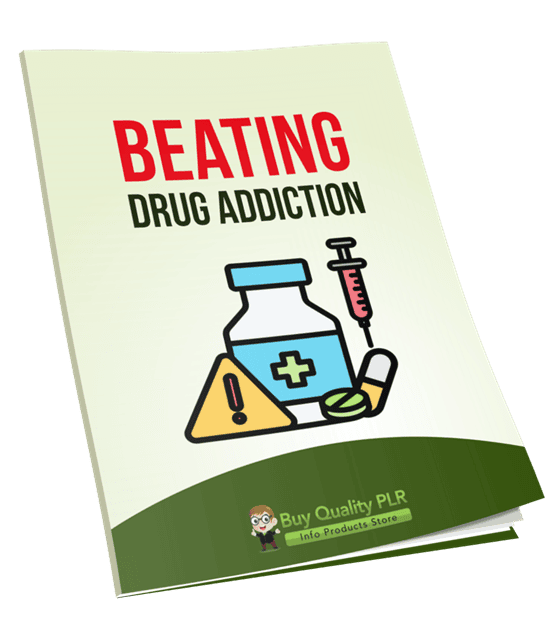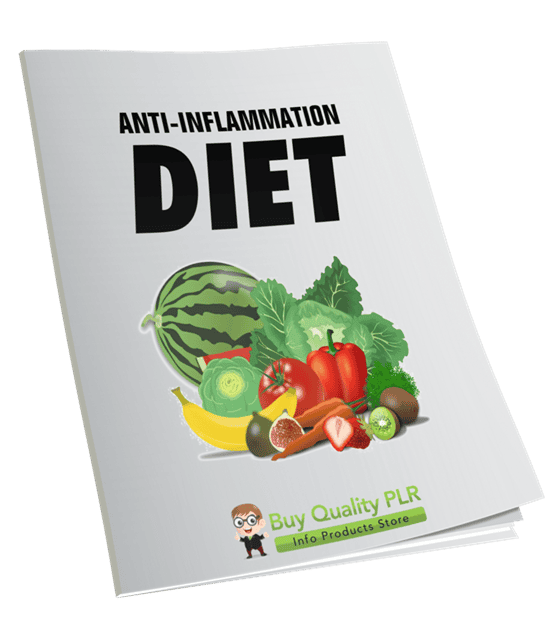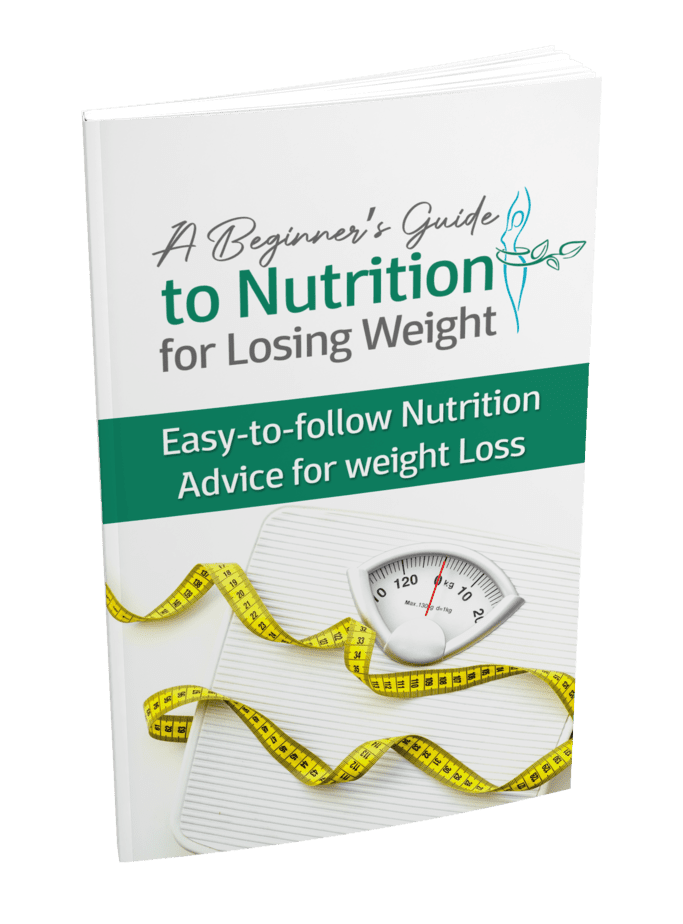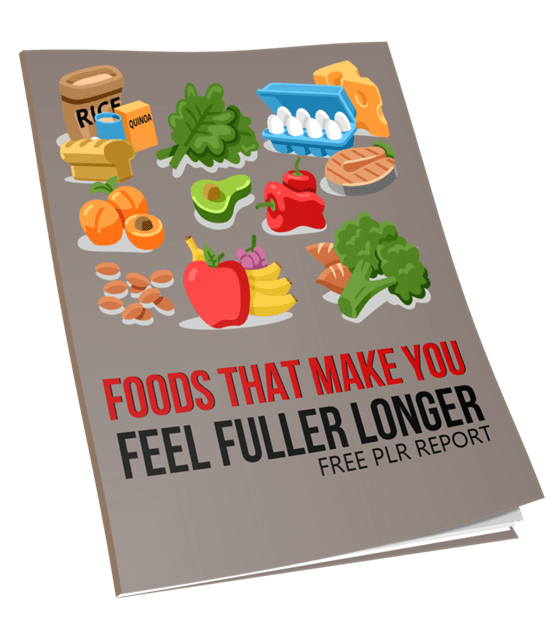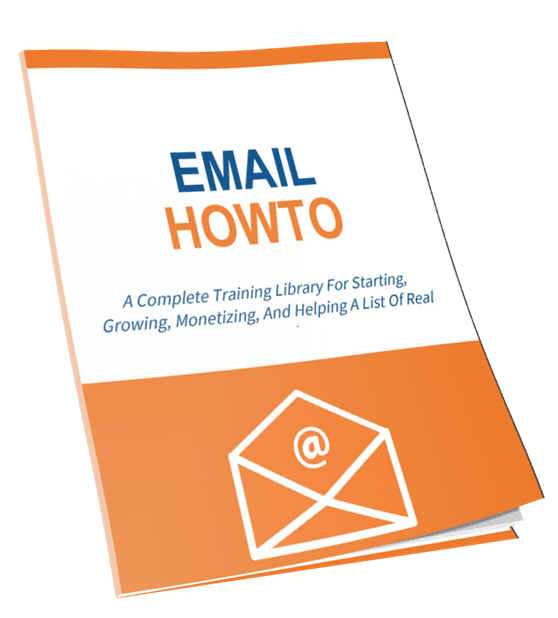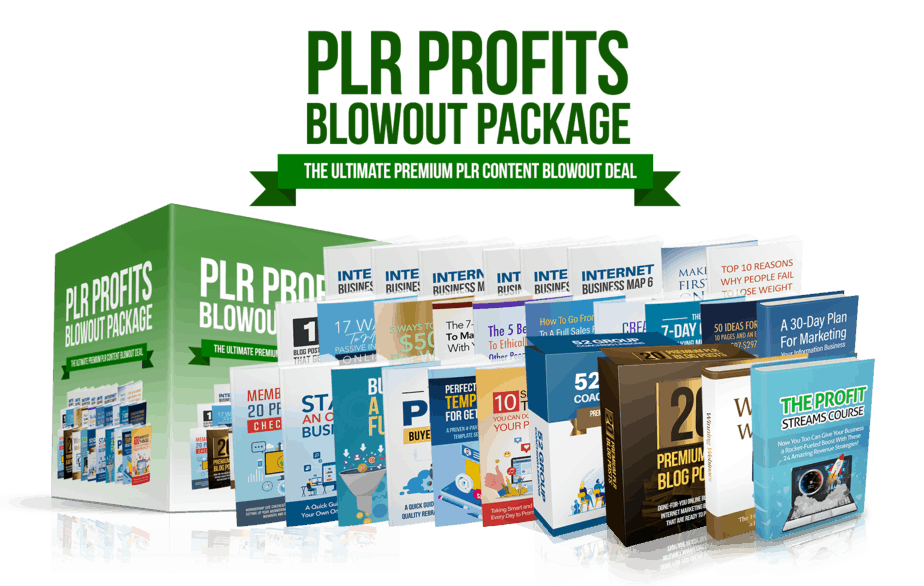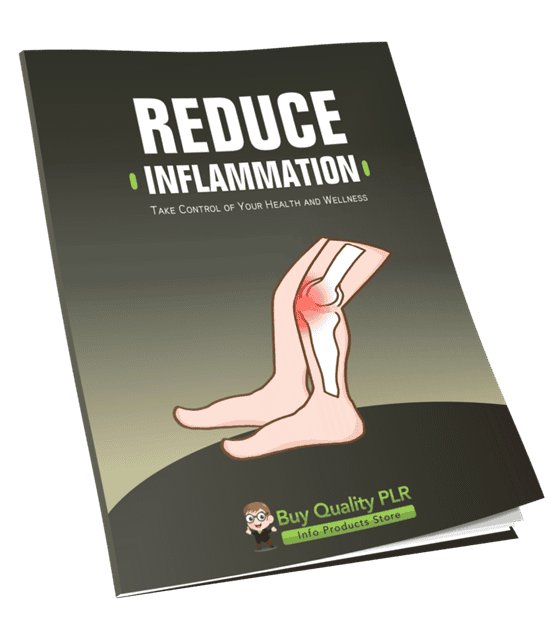
Reduce Inflammation PLR Course 26k Words
in Health PLR , Health PLR eBooks , PLR Checklists , PLR eBooks , PLR eCourses , PLR List Building Reports , Premium PLR , Premium PLR eBooks , Premium PLR Reports , Premium White Label Brandable PLR Coaching Courses , Private Label Rights Products , Self Help PLR , Self Help PLR eBooks , Wellness PLR , Wellness PLR eBooksChoose Your Desired Option(s)
has been added to your cart!
have been added to your cart!
#reduceinflammation #healthplr #wellnessplr #antiinflammatory #plrcourse #nutritioncontent #contentmarketing #healthyliving #plrcontent #selfhelpcontent
Reduce Inflammation PLR Course – Take Control of Your Health and Wellness
Your body is your most valuable asset. Chronic inflammation can silently contribute to pain, fatigue, and serious health issues like heart disease, diabetes, and autoimmune conditions. But the good news? You can take control, reduce inflammation, and feel healthier, more energetic, and vibrant every day.
The Reduce Inflammation PLR Course is a comprehensive, step-by-step training program designed to teach individuals how to effectively lower inflammation, adopt healthier habits, and transform their overall well-being.
With 24,174 words of structured content, this PLR package is perfect for creating digital products, coaching programs, webinars, membership sites, or personal wellness guides.
Presenting…
Reduce Inflammation PLR Course 26k Words
Why This Course is Essential
Inflammation is a natural response to injury or infection—but when it becomes chronic, it can damage your health, decrease energy levels, and accelerate aging. Many people struggle with inflammation without even realizing it. Typical challenges include:
- Lack of awareness about triggers in diet, lifestyle, and environment
- Difficulty distinguishing between acute and chronic inflammation
- Confusion about which foods and supplements help reduce inflammation
- Limited knowledge of lifestyle changes that support long-term wellness
The Reduce Inflammation PLR Course empowers learners with practical strategies and actionable steps to reduce inflammation naturally, build healthier habits, and sustain improvements over time.
Who This Course is For
This course is ideal for:
- Individuals experiencing chronic inflammation, joint pain, or fatigue
- Health coaches, nutritionists, and wellness professionals seeking ready-made content for clients
- Digital entrepreneurs looking for PLR products to sell as e-courses, ebooks, or membership content
- Anyone who wants to take control of their health through evidence-based, natural strategies
Course Overview
The Reduce Inflammation PLR Course is divided into five detailed modules, each containing four actionable steps. The course is structured to guide learners from understanding inflammation to implementing practical, long-term solutions.
Module 1: Understanding Inflammation
Before reducing inflammation, you need to understand what it is and how it affects your body.
Step 1: What Is Inflammation?
- Explore the basics: inflammation is the body’s natural response to injury or infection.
- Understand the difference between protective inflammation and harmful chronic inflammation.
- Activity: Reflect on past experiences when inflammation caused discomfort or health issues.
Step 2: Acute vs. Chronic Inflammation
- Acute inflammation is short-term, like swelling from a cut, and is protective.
- Chronic inflammation is long-term, silent, and linked to serious diseases.
- Activity: Identify areas in your body or life where chronic inflammation may be present.
Step 3: Common Causes of Inflammation
- Discover everyday triggers such as processed foods, sugar, stress, and lack of sleep.
- Learn how sedentary lifestyle and environmental toxins contribute to inflammation.
- Activity: List your potential inflammation triggers to understand where to focus changes.
Step 4: Signs and Symptoms
- Identify physical symptoms: joint pain, bloating, fatigue, headaches.
- Recognize emotional and cognitive signs, including brain fog and irritability.
- Activity: Track symptoms for one week to establish a baseline before lifestyle changes.
Module Benefits: Learners will develop a clear understanding of inflammation, its causes, and early warning signs, setting the stage for effective interventions.
Module 2: Nutrition for Reducing Inflammation
Your diet plays a critical role in managing inflammation. This module explores foods that heal, foods that harm, and practical strategies for meal planning.
Step 1: Anti-Inflammatory Foods
- Discover nutrient-rich foods like leafy greens, berries, fatty fish, nuts, and seeds.
- Learn how antioxidants and omega-3 fatty acids combat inflammation.
- Activity: Create a list of 10 anti-inflammatory foods to include in your meals.
Step 2: Foods to Avoid
- Identify foods that trigger inflammation: processed snacks, sugar, refined carbs, and trans fats.
- Learn how to read labels to avoid hidden inflammatory ingredients.
- Activity: Audit your pantry and replace at least 3 inflammatory items with healthier alternatives.
Step 3: Meal Planning
- Learn to create balanced, anti-inflammatory meals that are simple and sustainable.
- Explore breakfast, lunch, dinner, and snack ideas that fight inflammation naturally.
- Activity: Prepare a one-week meal plan using anti-inflammatory ingredients.
Step 4: Hydration Tips
- Understand the importance of water in flushing out toxins and supporting metabolic processes.
- Explore anti-inflammatory beverages such as green tea, turmeric lattes, and herbal infusions.
- Activity: Track water and beverage intake daily for one week to ensure proper hydration.
Module Benefits: Learners will gain the knowledge and practical tools to adjust their diet, reduce inflammation, and support overall health.
Module 3: Lifestyle Adjustments
Lifestyle changes are essential for sustainable inflammation reduction. This module focuses on movement, stress management, sleep, and environmental factors.
Step 1: Exercise and Movement
- Learn how gentle physical activity, like walking, yoga, and stretching, lowers inflammatory markers.
- Understand the importance of daily movement and strength exercises.
- Activity: Design a 20-minute daily movement plan for one week.
Step 2: Stress Management
- Explore the link between stress and inflammation.
- Practice techniques like deep breathing, meditation, journaling, and mindfulness.
- Activity: Implement a 5-minute daily stress-reduction practice.
Step 3: Sleep Optimization
- Understand how poor sleep triggers inflammatory responses.
- Learn tips for improving sleep quality: consistent schedule, limiting screens, and creating a restful environment.
- Activity: Track sleep habits and implement one improvement strategy.
Step 4: Avoiding Toxins
- Identify environmental and household toxins that contribute to inflammation.
- Learn practical strategies to reduce exposure, such as natural cleaning products and air filters.
- Activity: Replace one toxic household item with a safer alternative.
Module Benefits: Learners will develop practical habits that reduce inflammation naturally and sustainably.
Module 4: Supplements and Natural Remedies
This module covers safe, evidence-based supplements and natural approaches to support inflammation reduction.
Step 1: Anti-Inflammatory Supplements
- Learn about turmeric, omega-3s, probiotics, and their role in reducing inflammation.
- Discover dosage guidelines, safety tips, and combination strategies.
- Activity: Identify which supplements may benefit your needs and discuss with a healthcare professional.
Step 2: Herbal Remedies
- Explore natural options like ginger, aloe vera, and chamomile to soothe inflammation.
- Learn preparation methods, dosages, and best use cases.
- Activity: Integrate one herbal remedy into your daily routine.
Step 3: Essential Oils
- Discover how oils like lavender, eucalyptus, and frankincense can support wellness.
- Learn methods of application: diffusion, topical, or massage.
- Activity: Choose one oil and create a simple daily routine.
Step 4: Consultation and Safety
- Understand the importance of consulting healthcare professionals before starting any supplement regimen.
- Learn potential interactions with medications and contraindications.
- Activity: Schedule a consultation to review your supplement plan.
Module Benefits: Learners gain knowledge to safely complement lifestyle and dietary changes with supplements and natural remedies.
Module 5: Building Long-Term Habits
Sustainable results require consistent tracking, motivation, and adaptation. This module ensures learners can maintain low inflammation and optimal health long-term.
Step 1: Tracking Progress
- Set up methods to monitor improvements: symptom tracking, journaling, or wellness apps.
- Activity: Log symptoms, meals, and habits for one week to measure improvement.
Step 2: Staying Motivated
- Learn strategies for maintaining enthusiasm, including support groups, accountability partners, and apps.
- Activity: Join a community or set up a weekly check-in with a friend.
Step 3: Adapting to Challenges
- Understand that setbacks are normal and learn how to adjust without guilt.
- Explore strategies to stay flexible and resilient during travel, holidays, or busy periods.
- Activity: Identify one upcoming challenge and plan a strategy to navigate it.
Step 4: Celebrating Success
- Recognize milestones to reinforce positive behavior.
- Reflect on physical, mental, and emotional improvements.
- Activity: Create a “celebration ritual” for achievements, however small.
Module Benefits: Learners develop lifelong habits to keep inflammation low and health optimized.
Bonus Materials
- Reduce Inflammation Checklist (484 words): Step-by-step action plan for diet, lifestyle, and supplements.
- FAQs (982 words): Answers to common questions about inflammation, diet, and lifestyle strategies.
- Salespage Copy (637 words): Prewritten marketing content to help promote the course.
How to Use and Profit from This PLR Course
- Sell the full course as a complete digital product.
- Break modules into mini-products ($10–$20 each).
- Bundle with other wellness courses for $47–$97.
- Create a membership site with ongoing access to generate recurring revenue.
- Convert to audio, video, or webinar series for coaching programs.
- Use excerpts as lead magnets to build email lists.
- Flip the content to create a standalone wellness website.
Licensing Terms
Permissions:
- Sell, edit, and repurpose content.
- Claim copyright with 75% modification.
- Use in coaching, e-learning, or digital products.
Restrictions:
- Cannot transfer PLR rights.
- Maximum affiliate commission: 75%.
- Cannot give full content away for free.
- Cannot bundle without additional purchase.
Why This PLR Course Stands Out
- 24,174 words of structured, actionable content.
- Covers diet, lifestyle, supplements, and habit-building for inflammation reduction.
- Bonus materials for checklists, FAQs, and prewritten sales copy.
- Flexible PLR ready for digital products, membership sites, webinars, or coaching programs.
Take control of your health today with the Reduce Inflammation PLR Course—a ready-made, actionable, and profitable solution for wellness professionals, entrepreneurs, and anyone looking to improve health naturally.
has been added to your cart!
have been added to your cart!
Here A Sample of Reduce Inflammation PLR Course
Module 1: Understanding Inflammation
Step 1: What Is Inflammation?
Learn the basics of inflammation: what it is, why it happens, and how it can be both helpful and harmful.
1. What Is Inflammation?
Inflammation is your body’s natural response to injury, infection, or harmful stimuli. It’s an essential part of your immune system’s defense mechanism, acting like an internal alarm system.
- Think of it as your body’s way of signaling to the immune system, “Help is needed here!”
- When you cut yourself, for instance, your body sends white blood cells to the area to fight off any bacteria and begin the healing process.
In simpler terms, inflammation is the body’s effort to protect itself and repair damage. However, it’s not always as straightforward as it sounds, which leads us to the next part.
2. Why Does Inflammation Happen?
Inflammation occurs in response to triggers, which can range from physical injuries to infections, toxins, or even stress. These triggers activate the immune system, setting off a cascade of reactions:
- Trigger Event: For example, you scrape your knee, eat a meal high in trans fats, or encounter an allergen.
- Immune System Activation: Your body identifies a threat and sends out immune cells to the affected area.
- Inflammatory Response: Chemicals like histamine, prostaglandins, and cytokines are released. These chemicals cause redness, swelling, heat, and pain—hallmarks of inflammation.
This process is incredibly efficient when it comes to acute (short-term) issues. However, when the triggers are constant or unresolved, inflammation becomes chronic, which can lead to more harm than good.
3. How Can Inflammation Be Helpful?
Inflammation is vital for survival. Without it, your body wouldn’t be able to fight infections, heal wounds, or recover from illness. Here’s how it helps:
- Wound Healing: Imagine a cut on your hand. Inflammation ensures white blood cells and clotting factors are rushed to the site to prevent infection and close the wound.
- Fighting Infection: When you have the flu, inflammation causes fever. While uncomfortable, the heat can make your body less hospitable to viruses and bacteria.
- Neutralizing Threats: Inflammation is like a well-trained guard dog—it alerts your body to danger and takes steps to remove it.
Acute inflammation is temporary and resolves once the body heals, making it a necessary and beneficial process.
4. How Can Inflammation Be Harmful?
When inflammation becomes chronic, it can stop being your friend and turn into a silent threat. Chronic inflammation happens when the immune system remains active even when there’s no clear danger. Here’s how it harms your body:
- Tissue Damage: Prolonged inflammation can start to attack healthy tissues, leading to conditions like rheumatoid arthritis.
- Increased Risk of Diseases: Chronic inflammation is linked to serious health issues such as heart disease, diabetes, and cancer.
- Worsened Aging: Often referred to as “inflammaging,” chronic inflammation accelerates the aging process.
The difference between helpful and harmful inflammation often lies in how long it lasts and what’s causing it. Acute inflammation is like a fire drill—short and purposeful. Chronic inflammation, on the other hand, is like a fire alarm that won’t stop ringing, causing chaos instead of order.
Recap and Key Takeaways
By the end of this step, you should understand:
- What inflammation is: Your body’s natural defense mechanism.
- Why it happens: To fight threats or heal injuries.
- How it helps: Protects and heals in the short term.
- How it harms: Prolonged inflammation leads to chronic health issues.
Understanding these basics is critical before diving into strategies to reduce inflammation. This knowledge forms the foundation for the rest of the course, ensuring you can make informed choices to manage and prevent chronic inflammation effectively.
Step 2: Acute vs. Chronic Inflammation
Understand the difference between short-term (acute) inflammation and long-term (chronic) inflammation.
1. What Is Acute Inflammation?
Acute inflammation is the body’s immediate response to injury, infection, or harmful stimuli. Think of it as a quick, efficient reaction designed to protect and heal the body in the short term.
Key Features of Acute Inflammation:
- Trigger: Typically caused by a specific event such as a cut, sprain, or infection (e.g., a cold).
- Duration: It is short-lived, usually lasting from a few hours to a few days.
- Signs: The classic signs include redness, swelling, heat, pain, and sometimes loss of function in the affected area.
Step-by-Step Process of Acute Inflammation:
- Trigger Detection: When your body senses an injury or pathogen, it activates an immune response.
- Chemical Release: Chemicals like histamines and cytokines are released to increase blood flow to the area.
- White Blood Cell Activation: Immune cells rush to the site to fight off invaders and begin the repair process.
- Resolution: Once the threat is neutralized or the injury heals, the inflammation subsides.
Example: If you sprain your ankle, it might swell and feel warm for a few days. This inflammation helps the healing process and gradually reduces as the injury recovers.
2. What Is Chronic Inflammation?
Chronic inflammation, unlike acute inflammation, is long-term and can persist for months or even years. It often occurs when the immune system continues to activate without resolving the underlying issue, leading to ongoing damage.
Key Features of Chronic Inflammation:
- Trigger: Often caused by ongoing irritants, infections, autoimmune conditions, or lifestyle factors such as poor diet and stress.
- Duration: Long-lasting, sometimes persisting for years.
- Signs: Symptoms are more subtle and can include fatigue, joint pain, digestive issues, or low-grade fever.
Step-by-Step Process of Chronic Inflammation:
- Unresolved Trigger: The body perceives a continuous threat, such as an autoimmune disorder, obesity, or exposure to toxins.
- Prolonged Immune Activation: White blood cells and inflammatory chemicals are constantly released.
- Tissue Damage: Over time, chronic inflammation starts damaging healthy tissues and organs.
- Health Decline: If unchecked, this can contribute to diseases like diabetes, arthritis, heart disease, and even cancer.
Example: In rheumatoid arthritis, the immune system mistakenly attacks healthy joint tissues, leading to chronic inflammation and joint damage.
3. Key Differences Between Acute and Chronic Inflammation
It’s important to distinguish between the two types of inflammation to understand their roles in health and disease.
| Feature | Acute Inflammation | Chronic Inflammation |
| Duration | Short-term (hours to days) | Long-term (months to years) |
| Cause | Specific injury or infection | Persistent irritants or autoimmune issues |
| Symptoms | Redness, swelling, pain, heat | Fatigue, joint pain, subtle discomfort |
| Outcome | Healing and resolution | Tissue damage and potential disease |
Understanding these differences is essential for recognizing inflammation in its different forms and addressing it appropriately.
4. Why Understanding the Difference Matters
Knowing the distinction between acute and chronic inflammation is critical for managing your health.
- Acute Inflammation is a necessary and beneficial process for healing. However, it requires care and proper management to prevent complications (e.g., treating infections, resting injuries).
- Chronic Inflammation, on the other hand, can quietly wreak havoc on the body over time, often going unnoticed until it contributes to serious illnesses. Early recognition and intervention are key to preventing long-term health consequences.
Practical Application for Learners:
- Recognize Symptoms: Learn to differentiate between temporary inflammation (e.g., from a workout) and persistent symptoms that may indicate chronic inflammation.
- Track Duration: Pay attention to how long inflammation lasts. Anything beyond a few days may warrant further investigation.
- Lifestyle Choices: Adopt habits that reduce the risk of chronic inflammation, such as a healthy diet, regular exercise, and stress management.
Recap and Key Takeaways
By the end of this step, you should be able to:
- Define Acute Inflammation: A short-term, protective response that aids in healing.
- Define Chronic Inflammation: A long-term, harmful response that can lead to serious health issues.
- Differentiate Between the Two: Based on triggers, symptoms, duration, and outcomes.
- Understand the Importance: Acute inflammation helps; chronic inflammation harms. Knowing the difference empowers you to take control of your health.
This understanding lays the groundwork for recognizing and addressing inflammation effectively as we move forward in the course.
Step 3: Common Causes of Inflammation
Explore everyday triggers like poor diet, stress, and lack of sleep that lead to inflammation.
Inflammation doesn’t arise out of nowhere—it’s often a reaction to various factors in our environment, lifestyle, and habits. By understanding the most common causes of inflammation, you can take proactive steps to reduce its impact on your health.
1. Poor Diet: A Primary Culprit
Your diet has a significant influence on inflammation. Certain foods can trigger inflammatory responses in the body, especially when consumed in excess or on a regular basis.
How Poor Diet Leads to Inflammation:
- Excess Sugar: High levels of sugar in foods and drinks lead to a spike in blood sugar and insulin, which triggers the release of inflammatory cytokines.
- Processed Foods: Packaged snacks, fast food, and processed meats contain trans fats, artificial additives, and preservatives—all of which contribute to chronic inflammation.
- Refined Carbohydrates: Foods like white bread, pastries, and pasta are stripped of nutrients and fiber, causing blood sugar spikes that promote inflammation.
- Omega-6 Imbalance: While omega-6 fatty acids (found in many vegetable oils) are necessary in moderation, excess intake can fuel inflammatory pathways, especially when omega-3 intake is low.
Steps to Address This Trigger:
- Limit your intake of sugary foods and beverages.
- Replace processed snacks with whole, nutrient-dense foods like fruits, vegetables, and nuts.
- Focus on a balanced diet rich in anti-inflammatory foods such as fatty fish, leafy greens, and whole grains.
- Ensure an appropriate ratio of omega-6 to omega-3 fats by including sources like salmon, walnuts, and flaxseeds in your diet.
2. Chronic Stress: The Silent Agitator
Stress is a natural part of life, but when it becomes chronic, it can fuel inflammation in the body.
How Stress Leads to Inflammation:
- Cortisol Dysregulation: When you’re stressed, your body releases cortisol, a hormone designed to reduce inflammation. However, in chronic stress, your body can become resistant to cortisol, leaving inflammation unchecked.
- Increased Pro-inflammatory Chemicals: Chronic stress prompts your body to produce inflammatory cytokines, contributing to conditions like heart disease and depression.
Steps to Address This Trigger:
- Practice relaxation techniques like deep breathing, meditation, or yoga to lower stress levels.
- Set boundaries in your work and personal life to avoid burnout.
- Engage in physical activity, as regular exercise helps manage stress and reduce inflammation.
- Seek professional counseling or therapy if stress feels overwhelming or unmanageable.
3. Lack of Sleep: Disrupting Recovery
Sleep is the body’s time to repair and rejuvenate, making it a critical factor in managing inflammation. Poor sleep disrupts this balance, leading to heightened inflammatory responses.
How Lack of Sleep Leads to Inflammation:
- Increased Inflammatory Markers: Studies show that insufficient sleep increases levels of C-reactive protein (CRP) and cytokines, both of which are markers of inflammation.
- Weakened Immune System: Sleep deprivation reduces the body’s ability to fight infections, which can prolong inflammation.
Steps to Address This Trigger:
- Aim for 7–9 hours of quality sleep each night.
- Establish a consistent sleep schedule, going to bed and waking up at the same times daily.
- Create a sleep-friendly environment by keeping your bedroom dark, quiet, and cool.
- Avoid caffeine and electronic screens at least two hours before bedtime.
4. Sedentary Lifestyle: Movement Matters
A lack of physical activity is another common cause of inflammation. Sitting for long periods or leading a predominantly sedentary lifestyle can increase inflammatory markers in the body.
How Sedentary Behavior Leads to Inflammation:
- Reduced Circulation: Physical inactivity slows down blood flow, which can cause inflammation in the blood vessels.
- Weight Gain: A sedentary lifestyle contributes to obesity, a major risk factor for chronic inflammation.
Steps to Address This Trigger:
- Incorporate at least 30 minutes of moderate exercise (e.g., brisk walking, cycling) into your daily routine.
- Take breaks to stand, stretch, or move around if you sit for long hours at work.
- Engage in strength training exercises to maintain muscle mass and support healthy joints.
- Make physical activity part of your social life by joining sports, dance classes, or group fitness programs.
5. Environmental Toxins: Hidden Triggers
Exposure to toxins in the environment—such as air pollution, chemicals in household products, or pesticides—can contribute to low-grade, chronic inflammation.
How Environmental Toxins Lead to Inflammation:
- Oxidative Stress: Toxins increase the production of free radicals in the body, causing damage to cells and tissues.
- Immune System Overload: Persistent exposure can overstimulate the immune system, leading to chronic inflammation.
Steps to Address This Trigger:
- Use natural, non-toxic cleaning and personal care products whenever possible.
- Eat organic foods to minimize exposure to pesticides and harmful chemicals.
- Stay indoors on days with poor air quality and consider using an air purifier at home.
- Hydrate well to flush toxins out of your system and support cellular health.
Recap and Key Takeaways
By the end of this step, you should understand:
- Common Triggers: Poor diet, stress, lack of sleep, sedentary lifestyle, and environmental toxins are major contributors to inflammation.
- How They Work: Each trigger disrupts the body’s natural balance and fuels inflammatory pathways.
- Practical Solutions: Small, actionable changes can significantly reduce these triggers and support overall health.
Understanding the causes of inflammation allows you to identify and address these triggers in your own life, paving the way for reduced inflammation and improved well-being.
Step 4: Signs and Symptoms
Identify physical and emotional signs of inflammation in your body.
Inflammation can manifest in various ways, ranging from subtle symptoms to more obvious health issues. By learning to recognize the signs, you can take proactive steps to address the root cause and improve your overall well-being.
1. Recognizing Physical Signs of Inflammation
The physical signs of inflammation can be either localized (in one area) or systemic (throughout the body).
a. Localized Inflammation
Localized inflammation occurs in a specific area where your body is responding to injury or infection.
Key Symptoms:
- Redness and Warmth: The affected area may appear red and feel warm to the touch due to increased blood flow.
- Swelling: Fluid buildup around the injured or infected area can cause noticeable puffiness.
- Pain or Tenderness: The inflammation process sensitizes nerve endings, resulting in discomfort or pain.
- Restricted Mobility: If the inflammation occurs near a joint, it can make movement difficult or painful.
Example: A sprained ankle may exhibit redness, swelling, and pain as it heals through inflammation.
b. Systemic Inflammation
Systemic inflammation is more subtle but can have widespread effects on the body.
Key Symptoms:
- Fatigue: Persistent tiredness, even with adequate rest, can signal underlying inflammation.
- Fever or Chills: Infections often trigger a fever as part of the inflammatory response.
- Digestive Issues: Bloating, diarrhea, or constipation can indicate inflammation in the gastrointestinal tract.
- Skin Problems: Conditions like rashes, acne, or eczema may be signs of inflammatory skin issues.
Example: Chronic inflammation in the gut might result in digestive discomfort and persistent fatigue.
2. Recognizing Emotional Signs of Inflammation
Inflammation doesn’t only affect your body; it can also impact your emotional well-being.
a. Mood Changes
Inflammation in the body can alter brain chemistry, leading to noticeable shifts in mood.
Key Symptoms:
- Irritability: Feeling unusually short-tempered or on edge.
- Anxiety: Persistent feelings of worry or unease without a clear cause.
- Depression: Chronic inflammation is linked to symptoms of depression, including sadness, hopelessness, or a lack of interest in activities.
b. Brain Fog
Inflammation in the body can affect cognitive function, leading to:
- Difficulty concentrating or focusing.
- Forgetfulness or poor memory.
- A general sense of mental fatigue.
Example: A poor diet and lack of sleep may trigger inflammation that leads to mood swings and difficulty concentrating.
3. Differentiating Between Temporary and Chronic Symptoms
It’s important to distinguish between inflammation caused by temporary issues (e.g., a workout or minor injury) and chronic inflammation that may signal a deeper health problem.
Temporary Inflammation Symptoms:
- Symptoms last for a short period (hours to days).
- Associated with specific triggers like an infection, injury, or intense physical activity.
- Improves with rest, proper care, and time.
Example: Muscle soreness after exercise is a sign of acute, temporary inflammation.
Chronic Inflammation Symptoms:
- Symptoms persist for weeks, months, or years.
- Often vague and difficult to trace to a specific cause.
- Accompanied by conditions like autoimmune disorders, heart disease, or diabetes.
Example: Joint pain and fatigue that persist for months may indicate chronic inflammation from an underlying condition like arthritis.
4. Practical Steps to Identify and Monitor Inflammation
Recognizing inflammation requires awareness of your body and careful observation.
a. Pay Attention to Your Body’s Signals
- Keep a journal of symptoms such as pain, fatigue, or digestive discomfort.
- Note when symptoms worsen (e.g., after eating certain foods or during stressful periods).
b. Use Diagnostic Tools
- Schedule regular checkups and discuss persistent symptoms with your healthcare provider.
- Request tests for inflammatory markers like C-reactive protein (CRP) or erythrocyte sedimentation rate (ESR).
c. Assess Emotional Well-being
- Reflect on any recent changes in mood, focus, or stress levels.
- Consider if these emotional shifts coincide with physical symptoms like fatigue or digestive issues.
d. Make Small Adjustments
- If you notice triggers (e.g., specific foods or habits), experiment with eliminating them to see if symptoms improve.
- Incorporate lifestyle changes like mindfulness or anti-inflammatory foods to manage mild symptoms.
Recap and Key Takeaways
By the end of this step, you should be able to:
- Identify Physical Symptoms: Recognize redness, swelling, pain, fatigue, and other physical signs of inflammation.
- Recognize Emotional Symptoms: Understand how inflammation may contribute to mood changes and cognitive issues.
- Distinguish Between Temporary and Chronic Inflammation: Evaluate whether symptoms are short-term or require further attention.
- Monitor and Act: Use practical strategies to track your symptoms, consult professionals, and make lifestyle adjustments.
By becoming attuned to the signs and symptoms of inflammation, you empower yourself to take early action, preventing it from escalating into more serious health concerns. This awareness is a vital step toward a healthier, more balanced life.
We’re also giving these extra bonuses
Reduce Inflammation – Checklist
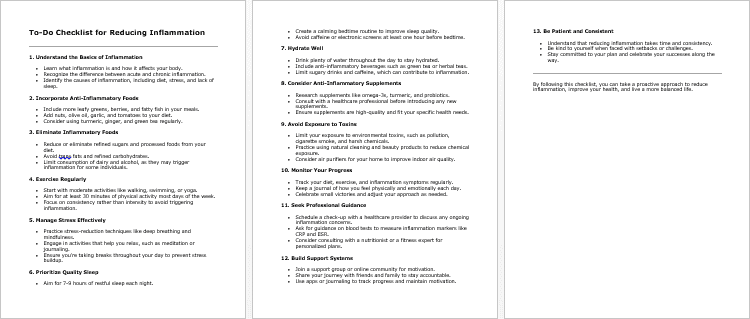
Reduce Inflammation – FAQs

Reduce Inflammation – Salespage Content
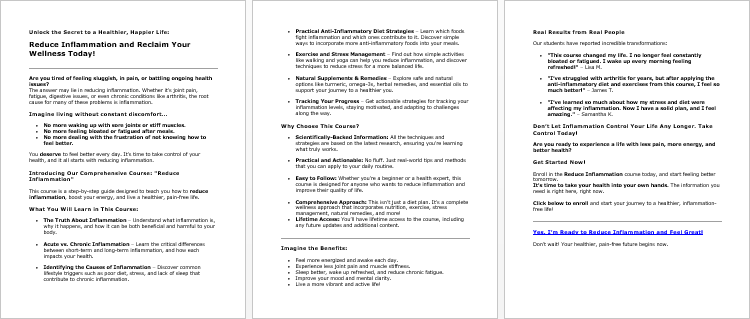
Package Details:
Word Count: 24 174 Words
Number of Pages: 99
Reduce Inflammation – Bonus Content
Checklist
Word Count: 484 words
FAQs
Word Count: 982 words
Salespage Content
Word Count: 637 words
Total Word Count: 26 277 Words
Your PLR License Terms
PERMISSIONS: What Can You Do With These Materials?
Sell the content basically as it is (with some minor tweaks to make it “yours”).
If you are going to claim copyright to anything created with this content, then you must substantially change at 75% of the content to distinguish yourself from other licensees.
Break up the content into small portions to sell as individual reports for $10-$20 each.
Bundle the content with other existing content to create larger products for $47-$97 each.
Setup your own membership site with the content and generate monthly residual payments!
Take the content and convert it into a multiple-week “eclass” that you charge $297-$497 to access!
Use the content to create a “physical” product that you sell for premium prices!
Convert it to audios, videos, membership site content and more.
Excerpt and / or edit portions of the content to give away for free as blog posts, reports, etc. to use as lead magnets, incentives and more!
Create your own original product from it, set it up at a site and “flip” the site for megabucks!
RESTRICTIONS: What Can’t You Do With These Materials?
To protect the value of these products, you may not pass on the rights to your customers. This means that your customers may not have PLR rights or reprint / resell rights passed on to them.
You may not pass on any kind of licensing (PLR, reprint / resell, etc.) to ANY offer created from ANY PORTION OF this content that would allow additional people to sell or give away any portion of the content contained in this package.
You may not offer 100% commission to affiliates selling your version / copy of this product. The maximum affiliate commission you may pay out for offers created that include parts of this content is 75%.
You are not permitted to give the complete materials away in their current state for free – they must be sold. They must be excerpted and / or edited to be given away, unless otherwise noted. Example: You ARE permitted to excerpt portions of content for blog posts, lead magnets, etc.
You may not add this content to any part of an existing customer order that would not require them to make an additional purchase. (IE You cannot add it to a package, membership site, etc. that customers have ALREADY paid for.)
Share Now!


